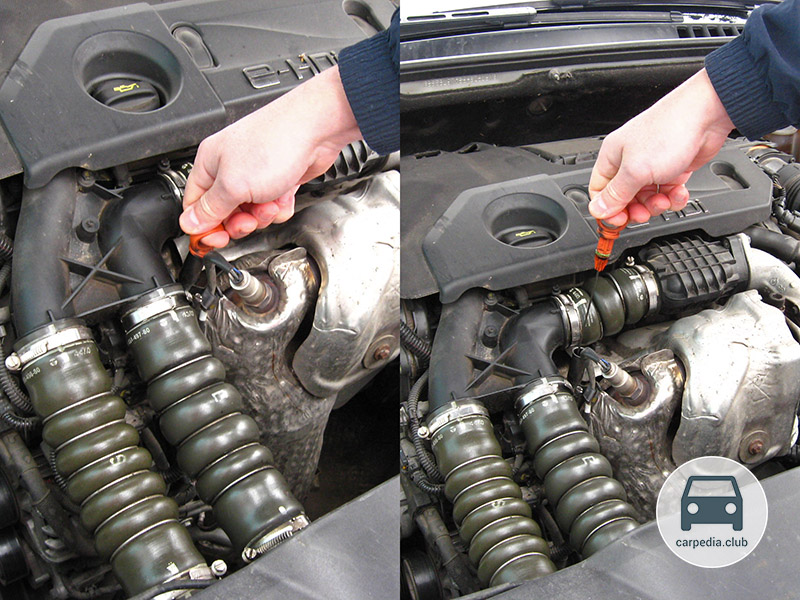Parts and consumables:
- Cloth gloves (optional)
- rags
- Synthetic engine oil Total Quartz Ineo ECS 5W-30 — 151510
Notes:
To ensure that your vehicle's engine runs smoothly, it is recommended that you check the oil every 2,000 km or before a long trip.
Citroen C5 engine oil is a lubricant between its moving elements. Insufficient levels will result in premature engine wear and contamination.
Checking the oil level should be carried out no earlier than 30 minutes after the engine has stopped. If the check is carried out immediately after turning off the engine, part of the oil will remain in the upper part of the engine and will not have time to drain into the sump, as a result of which the measurement result will not be correct.
Top up with Citroen C5 engine oil of the same brand, viscosity and type as the previously filled one.
1 . Install the car on a flat horizontal surface . Open the hood and lock it in the raised position. The oil level indicator (dipstick) with an orange plastic tip is located on the front right side of the engine block.


The engine oil filler is located on the right side of the cylinder head cover.

2. Remove the dipstick from the engine guide tube before checking the level.

Note:
Do not put a lot of effort to remove the probe. A little scrolling and pressing is only required to move it from its position.
3. Wipe the Citroen C5 oil dipstick with a rag to make it dry.

4. Install the dipstick back into the engine guide tube until it stops, wait a few seconds for the oil to leave a mark on the dipstick, and remove it again.


5. There are marks on the end of the dipstick: MIN is the minimum level and MAX is the maximum oil level. The normal Citroen C5 oil level should be between these marks, closer to the maximum. If the oil level is close to the bottom mark or even below it, add oil to the engine.

6. To top up the Citroen C5 oil, turn the oil filler cap counterclockwise and remove it.

7. Add the correct amount of engine oil, checking the level with the dipstick. Before removing the dipstick, wait 3 minutes for the oil to completely flow into the crankcase.

Note:
Under no circumstances should the upper mark (MAX) on the dipstick be exceeded. Therefore, it is better not to try to carry out ultra-precise, according to the top mark, oil filling into the car engine. Excess oil will be used up quickly, and oil burnout contributes to the formation of excessive deposits on engine parts. In addition, when the permissible level is exceeded, the crankshaft whips and foams the oil in the crankcase more intensively, which in some cases can contribute to the deterioration of lubrication.
Oil should be poured slowly. It is recommended to do this in small portions. It is necessary to stop periodically so that the oil has time to settle into the crankcase.
8. After topping up the oil, tighten the oil filler cap tightly. Clean up spilled liquid with a rag.

Note:
Operating the car with a level below the norm (MIN mark) can lead to engine damage and, as a result, costly repairs. If the engine oil level is above normal (MAX marks), this can cause an increase in oil consumption due to burnout, clogging of spark plugs and increased carbon deposits.
Prolonged and frequent contact of exposed body parts with used engine oil can lead to various skin conditions, including dermatitis and skin cancer. Therefore, excessive contact with oil should be avoided and after work, contamination should be thoroughly washed off the skin. Therefore, the use of gloves is recommended.
The article is missing:
- Photo of parts and consumables
Source: carpedia.club






![2 generation [2008 - 2016]](/uploads/Citroen_C5_2008_-_2015_.jpg)
